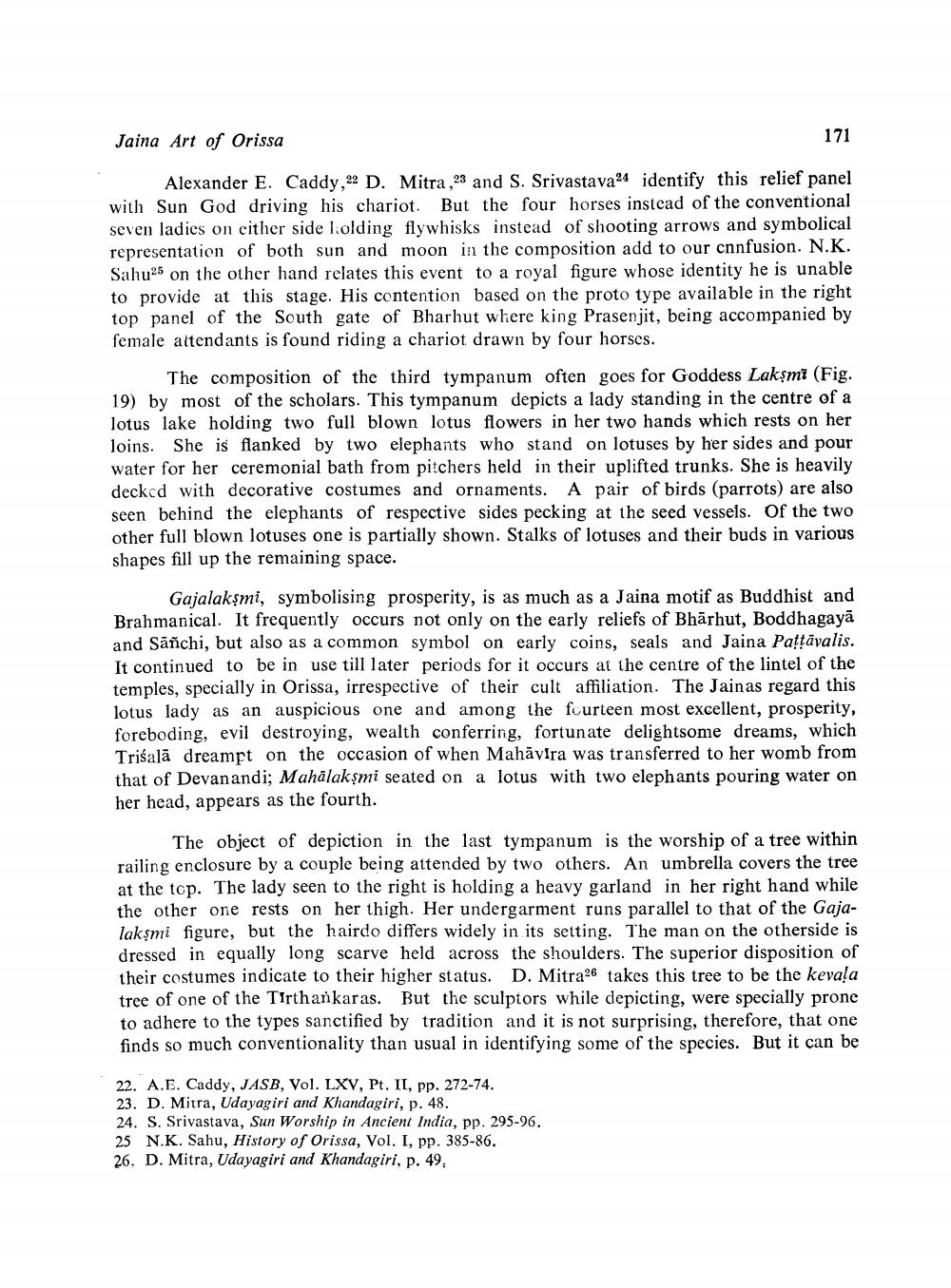________________
Jaina Art of Orissa
171
Alexander E. Caddy, D. Mitra, and S. Srivastava identify this relief panel with Sun God driving his chariot. But the four horses instead of the conventional seven ladies on either side lolding flywhisks instead of shooting arrows and symbolical representation of both sun and moon in the composition add to our cnnfusion. N.K. Sahu25 on the other hand relates this event to a royal figure whose identity he is unable to provide at this stage. His contention based on the proto type available in the right top panel of the South gate of Bharhut where king Prasenjit, being accompanied by female attendants is found riding a chariot drawn by four horses.
The composition of the third tympanum often goes for Goddess Laksmi (Fig. 19) by most of the scholars. This tympanum depicts a lady standing in the centre of a lotus lake holding two full blown lotus flowers in her two hands which rests on her loins. She is flanked by two elephants who stand on lotuses by her sides and pour water for her ceremonial bath from pitchers held in their uplifted trunks. She is heavily decked with decorative costumes and ornaments. A pair of birds (parrots) are also seen behind the elephants of respective sides pecking at the seed vessels. Of the two other full blown lotuses one is partially shown. Stalks of lotuses and their buds in various shapes fill up the remaining space.
Gajalaksmi, symbolising prosperity, is as much as a Jaina motif as Buddhist and Brahmanical. It frequently occurs not only on the early reliefs of Bharhut, Boddhagaya and Sanchi, but also as a common symbol on early coins, seals and Jaina Paṭṭāvalis. It continued to be in use till later periods for it occurs at the centre of the lintel of the temples, specially in Orissa, irrespective of their cult affiliation. The Jainas regard this lotus lady as an auspicious one and among the fourteen most excellent, prosperity, foreboding, evil destroying, wealth conferring, fortunate delightsome dreams, which Trisala dreampt on the occasion of when Mahavira was transferred to her womb from that of Devanandi; Mahālakṣmi seated on a lotus with two elephants pouring water on her head, appears as the fourth.
The object of depiction in the last tympanum is the worship of a tree within railing enclosure by a couple being attended by two others. An umbrella covers the tree at the top. The lady seen to the right is holding a heavy garland in her right hand while the other one rests on her thigh. Her undergarment runs parallel to that of the Gajalaksmi figure, but the hairdo differs widely in its setting. The man on the otherside is dressed in equally long scarve held across the shoulders. The superior disposition of their costumes indicate to their higher status. D. Mitra26 takes this tree to be the kevala tree of one of the Tirthankaras. But the sculptors while depicting, were specially prone to adhere to the types sanctified by tradition and it is not surprising, therefore, that one finds so much conventionality than usual in identifying some of the species. But it can be
22. A.E. Caddy, JASB, Vol. LXV, Pt. II, pp. 272-74.
23. D. Mitra, Udayagiri and Khandagiri, p. 48.
24. S. Srivastava, Sun Worship in Ancient India, pp. 295-96.
25 N.K. Sahu, History of Orissa, Vol. I, pp. 385-86. 26. D. Mitra, Udayagiri and Khandagiri, p. 49,




